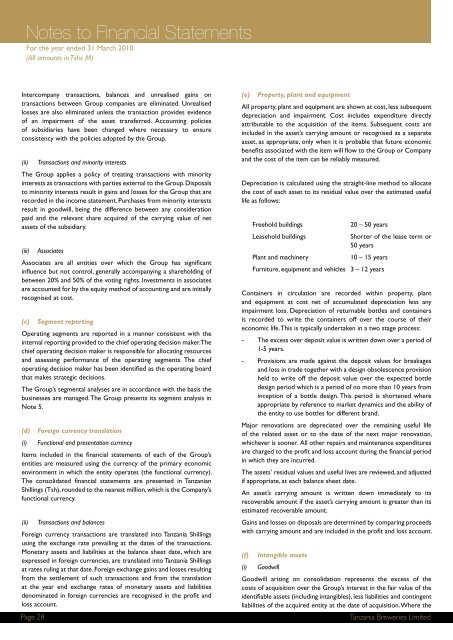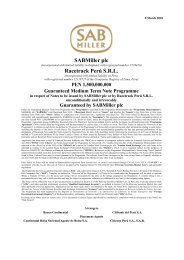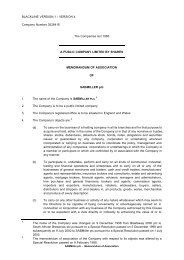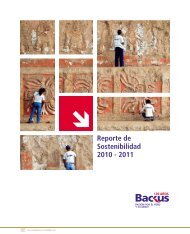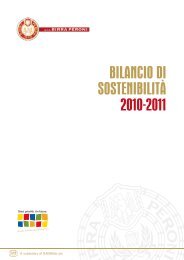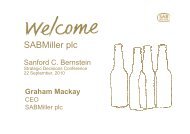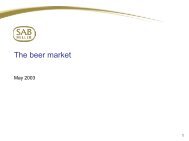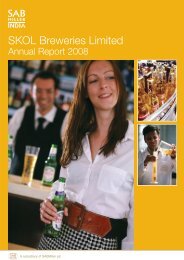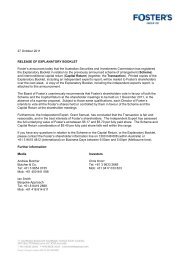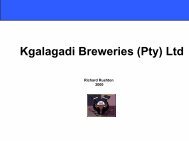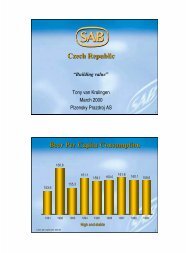Download the Tanzania Breweries Ltd 2010 Annual ... - SABMiller
Download the Tanzania Breweries Ltd 2010 Annual ... - SABMiller
Download the Tanzania Breweries Ltd 2010 Annual ... - SABMiller
Create successful ePaper yourself
Turn your PDF publications into a flip-book with our unique Google optimized e-Paper software.
Notes to Financial Statements<br />
For <strong>the</strong> year ended 31 March <strong>2010</strong><br />
(All amounts in Tshs M)<br />
Intercompany transactions, balances and unrealised gains on<br />
transactions between Group companies are eliminated. Unrealised<br />
losses are also eliminated unless <strong>the</strong> transaction provides evidence<br />
of an impairment of <strong>the</strong> asset transferred. Accounting policies<br />
of subsidiaries have been changed where necessary to ensure<br />
consistency with <strong>the</strong> policies adopted by <strong>the</strong> Group.<br />
(ii)<br />
Page 28<br />
Transactions and minority interests<br />
The Group applies a policy of treating transactions with minority<br />
interests as transactions with parties external to <strong>the</strong> Group. Disposals<br />
to minority interests result in gains and losses for <strong>the</strong> Group that are<br />
recorded in <strong>the</strong> income statement. Purchases from minority interests<br />
result in goodwill, being <strong>the</strong> difference between any consideration<br />
paid and <strong>the</strong> relevant share acquired of <strong>the</strong> carrying value of net<br />
assets of <strong>the</strong> subsidiary.<br />
(iii)<br />
Associates<br />
Associates are all entities over which <strong>the</strong> Group has significant<br />
influence but not control, generally accompanying a shareholding of<br />
between 20% and 50% of <strong>the</strong> voting rights. Investments in associates<br />
are accounted for by <strong>the</strong> equity method of accounting and are initially<br />
recognised at cost.<br />
(c)<br />
Segment reporting<br />
Operating segments are reported in a manner consistent with <strong>the</strong><br />
internal reporting provided to <strong>the</strong> chief operating decision maker. The<br />
chief operating decision maker is responsible for allocating resources<br />
and assessing performance of <strong>the</strong> operating segments. The chief<br />
operating decision maker has been identified as <strong>the</strong> operating board<br />
that makes strategic decisions.<br />
The Group’s segmental analyses are in accordance with <strong>the</strong> basis <strong>the</strong><br />
businesses are managed. The Group presents its segment analysis in<br />
Note 5.<br />
(d)<br />
(i)<br />
Foreign currency translation<br />
Functional and presentation currency<br />
Items included in <strong>the</strong> financial statements of each of <strong>the</strong> Group’s<br />
entities are measured using <strong>the</strong> currency of <strong>the</strong> primary economic<br />
environment in which <strong>the</strong> entity operates (<strong>the</strong> functional currency).<br />
The consolidated financial statements are presented in <strong>Tanzania</strong>n<br />
Shillings (Tsh), rounded to <strong>the</strong> nearest million, which is <strong>the</strong> Company’s<br />
functional currency.<br />
(ii)<br />
Transactions and balances<br />
Foreign currency transactions are translated into <strong>Tanzania</strong> Shillings<br />
using <strong>the</strong> exchange rate prevailing at <strong>the</strong> dates of <strong>the</strong> transactions.<br />
Monetary assets and liabilities at <strong>the</strong> balance sheet date, which are<br />
expressed in foreign currencies, are translated into <strong>Tanzania</strong> Shillings<br />
at rates ruling at that date. Foreign exchange gains and losses resulting<br />
from <strong>the</strong> settlement of such transactions and from <strong>the</strong> translation<br />
at <strong>the</strong> year end exchange rates of monetary assets and liabilities<br />
denominated in foreign currencies are recognised in <strong>the</strong> profit and<br />
loss account.<br />
(e)<br />
Property, plant and equipment<br />
All property, plant and equipment are shown at cost, less subsequent<br />
depreciation and impairment. Cost includes expenditure directly<br />
attributable to <strong>the</strong> acquisition of <strong>the</strong> items. Subsequent costs are<br />
included in <strong>the</strong> asset’s carrying amount or recognised as a separate<br />
asset, as appropriate, only when it is probable that future economic<br />
benefits associated with <strong>the</strong> item will flow to <strong>the</strong> Group or Company<br />
and <strong>the</strong> cost of <strong>the</strong> item can be reliably measured.<br />
Depreciation is calculated using <strong>the</strong> straight-line method to allocate<br />
<strong>the</strong> cost of each asset to its residual value over <strong>the</strong> estimated useful<br />
life as follows:<br />
Freehold buildings<br />
Leasehold buildings<br />
Plant and machinery<br />
20 – 50 years<br />
Shorter of <strong>the</strong> lease term or<br />
50 years<br />
10 – 15 years<br />
Furniture, equipment and vehicles 3 – 12 years<br />
Containers in circulation are recorded within property, plant<br />
and equipment at cost net of accumulated depreciation less any<br />
impairment loss. Depreciation of returnable bottles and containers<br />
is recorded to write <strong>the</strong> containers off over <strong>the</strong> course of <strong>the</strong>ir<br />
economic life. This is typically undertaken in a two stage process:<br />
- The excess over deposit value is written down over a period of<br />
1-5 years.<br />
- Provisions are made against <strong>the</strong> deposit values for breakages<br />
and loss in trade toge<strong>the</strong>r with a design obsolescence provision<br />
held to write off <strong>the</strong> deposit value over <strong>the</strong> expected bottle<br />
design period which is a period of no more than 10 years from<br />
inception of a bottle design. This period is shortened where<br />
appropriate by reference to market dynamics and <strong>the</strong> ability of<br />
<strong>the</strong> entity to use bottles for different brand.<br />
Major renovations are depreciated over <strong>the</strong> remaining useful life<br />
of <strong>the</strong> related asset or to <strong>the</strong> date of <strong>the</strong> next major renovation,<br />
whichever is sooner. All o<strong>the</strong>r repairs and maintenance expenditures<br />
are charged to <strong>the</strong> profit and loss account during <strong>the</strong> financial period<br />
in which <strong>the</strong>y are incurred.<br />
The assets’ residual values and useful lives are reviewed, and adjusted<br />
if appropriate, at each balance sheet date.<br />
An asset’s carrying amount is written down immediately to its<br />
recoverable amount if <strong>the</strong> asset’s carrying amount is greater than its<br />
estimated recoverable amount.<br />
Gains and losses on disposals are determined by comparing proceeds<br />
with carrying amount and are included in <strong>the</strong> profit and loss account.<br />
(f)<br />
(i)<br />
Intangible assets<br />
Goodwill<br />
Goodwill arising on consolidation represents <strong>the</strong> excess of <strong>the</strong><br />
costs of acquisition over <strong>the</strong> Group’s interest in <strong>the</strong> fair value of <strong>the</strong><br />
identifiable assets (including intangibles), less liabilities and contingent<br />
liabilities of <strong>the</strong> acquired entity at <strong>the</strong> date of acquisition. Where <strong>the</strong><br />
<strong>Tanzania</strong> <strong>Breweries</strong> Limited


